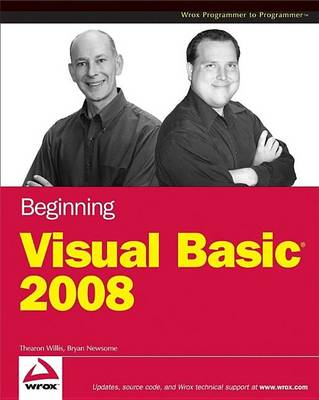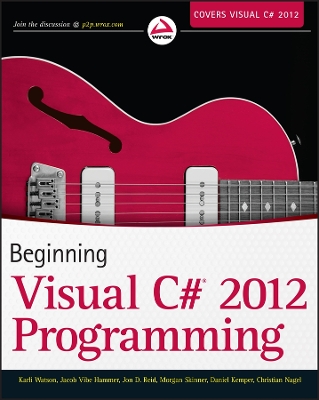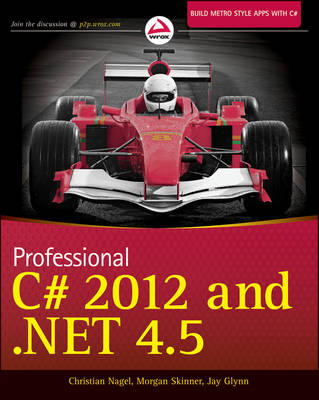Wrox Programmer to Programmer
4 total works
Beginning Microsoft Visual Basic 2008
by Karli Watson, Christian Nagel, Jacob Hammer Pedersen, Jon D. Reid, Morgan Skinner, Eric White, Thearon Willis, and Bryan Newsome
Once we've taught you the basics of creating working applications (creating the windows and controls, how your code should handle unexpected events, what object-oriented programming is, how to use it in your applications, and so on), we'll show you some of the areas you might want to try your hand at next. To this end, the book is organized as follows: Chapters 1 through 9 provide an introduction to Visual Studio 2008 and Windows programming. Chapter 6 provides an introduction to XAML and Windows Presentation Foundation (WPF) programming. Chapter 10 provides an introduction to application debugging and error handling. Chapters 11 through 13 provide an introduction to object-oriented programming and building objects. Chapter 14 provides an introduction to creating Windows Forms user controls. Chapter 15 provides an introduction to graphics in Windows applications. Chapters 16 and 17 provide an introduction to programming with databases and covers Access, SQL Server, ADO.NET and LINQ. Chapters 18 and 19 provide an introduction to ASP.NET and show you how to write applications for the Web.
Chapter 20 provides a brief introduction to XML, a powerful tool for integrating your applications--regardless of the language they were written in. Chapter 21 introduces you to web services and the Windows Communication Foundation (WCF). Chapter 22 introduces you to sequential workflows using the Windows Workflow Foundation (WF). Chapter 23 introduces you to building applications for mobile devices using the Compact Framework classes. Chapter 24 introduces you to deploying applications using ClickOnce technology. Chapter 25 provides some insight on where to go next in your journey to learn about VisualBasic 2008. Appendix A provides the answers to chapter exercises. Appendix B introduces the Microsoft Solution Framework. Appendix C provides some background on security. Appendix D provides insight into Windows CardSpace. Appendix E compares the differences between the latest versions of the .NET Framework.
Beginning Visual C# 2012 Programming
by Karli Watson, Jacob Vibe Hammer, Jon D. Reid, Morgan Skinner, Daniel Kemper, and Christian Nagel
Written for novice programmers who want to learn programming with C# and the .NET framework, this book offers programming basics such as variables, flow control, and object oriented programming. It then moves into web and Windows programming and data access (databases and XML). The authors focus on the tool that beginners use most often to program C#, the Visual C# 2012 development environment in Visual Studio 2012.
- Puts the spotlight on key beginning level topics with easy-to-follow instructions for Microsoft Visual C# 2012
- Explores how to program for variables, expressions, flow control, and functions
- Explains the debugging process and error handling as well as object oriented programming, and much more
Beginning Microsoft Visual C# 2012 Programming offers beginners a guide to writing effective programming code following simple step-by-step methods, each followed by the opportunity to try out newly acquired skills.
Professional C# 2012 and .NET 4.5
by Christian Nagel, Bill Evjen, Jay Glynn, Karli Watson, and Morgan Skinner
This guide is geared towards experienced programmers looking to update and enhance their skills in writing Windows applications, web apps, and Metro apps with C# and .NET 4.5. Packed with information about intermediate and advanced features, this book includes everything professional developers need to know about C# and putting it to work.
- Covers challenging .NET features including Language Integrated Query (LINQ), LINQ to SQL, LINQ to XML, WCF, WPF, Workflow, and Generics
- Puts the new Async keyword to work and features refreshers on .NET architecture, objects, types, inheritance, arrays, operators, casts, delegates, events, strings, regular expressions, collections, and memory management
- Explores new options and interfaces presented by Windows 8 development, WinRT, and Metro style apps
- Includes traditional Windows forms programming, ASP.NET web programming with C#, and working in Visual Studio 2012 with C#
Professional C# 2012 and .NET 4.5 is a comprehensive guide for experienced programmers wanting to maximize these technologies.



